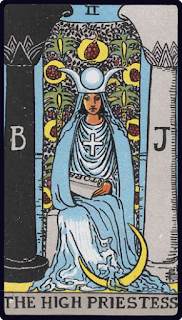
The High Priestess was traditionally known as the Popess, or La Papesse, later renamed the High Priestess by A. E. Waite when producing the Rider-Waite Deck. This change in name was intended to divorce the imagery of the Rider-Waite Deck from the authority and symbolism of the Church. As with the Pope which was renamed the Hierophant, this attempt to divorce the imagery of the cards largely fails.
The High Priestess and the Hierophant serve as the respective feminine and masculine polarities of the authoritarian nature of Spiritual discipline. The role of the High Priestess in particular serves as guardian of occult knowledge, she is a keeper of wisdom, the combination of knowledge and experience, this wisdom is such that the Fool is not yet ready to receive because they lack the experience necessary to understand and accept the knowledge she would impart. Nevertheless, the High Priestess shares this knowledge openly with those who ask it of her, and demonstrate their curiosity, even if that dispensation falls on deaf ears.
The High Priestess therefore represents wisdom, responsibility, and insight, and can be thought of as a source of strength and counsel who reserves judgement but instead attempts to nurture curiosity, not out of fear that her authority will be questioned but that greater understanding will lead to deeper faith..
The High Priestess focuses on utility that can be gained from wisdom rather than veracity, she does not question how or why power exists, instead she focuses on what we can do with it. Whether faith is founded or unfounded is irrelevant, the focus shifts to the strength of that faith and what can be achieved through that strength. In the inverted state this card represents our ignorance and disregard for the establishment and lived experience of others.
Wisdom is an equation that combines the elements of knowledge and experience, but we can only ever impart knowledge first-hand as all knowledge is self-evident when understood; all experience however can only be imparted second-hand we can only become aware of the experiences of others we cannot gain that experience for ourselves through their teaching no matter the depth of their explanation. We can only have a theoretical understanding of experience until we acquire it firsthand.
Our ignorance of experience is ultimately rooted in our arrogance that leads us to discount or discredit the experiences of others as inapplicable to us fuelled by the arrogant belief that we are different, or significantly unique that our experience would not be the same as others.
In the Rider-Waite deck, the High Priestess sits upon a throne at the entrance to the Temple of Solomon, the Great King who was revered for his wisdom; this Temple is denoted by the pillars marked by the letters 'B' and 'J' which represent Boaz and Jachin, the two pillars which the Bible says stood at the entrance to the Temple of Solomon. In addition, the High Priestess holds a scroll in her hand with the letters ‘TORA’ visible, representing the Torah, the first 5 books of the Hebrew Bible that served as the basis of law. The High Priestess is also sitting in front of a tapestry depicting pomegranates representing fertility and potential.
In contrast to the Judeo-Christian symbolism, the High Priestess is adorned with Egyptian symbols in the form of the crescent Moon at her feet and the globe embedded within her crown representing the Sun; each of these elements will reappear later as cards of their own right within the Major Arcana, their presence and our lack of understanding of their significance at this point of the Great Journey represents the foreshadowing of the journey to come, these are symbols that the Fool will not come to appreciate until their journey approaches its close.
The High Priestess can be used as a prompt to reflect on what you have already learned through life experience and what you have achieved. Crucially you should ask what other people often come to you seeking advice on, and to ask what qualities in yourself do they recognise which motivate them to seek your guidance in the first place, follow this question by asking if you give yourself enough recognition for having those qualities.
We are often good at giving other people advice but not so good at taking our own. We often have a greater insight into the struggles other people face than those we face ourselves because we abstract the minute details of other peoples' lives when we give counsel. We simplify problems, yet when it comes to following our own advice, conversely, we use the minute details of our lives to discredit our own advice convincing ourselves that while our advice would be helpful to others it would not apply to us as we are exceptions - this is the arrogance alluded to above.
The High Priestess can be a prompt to ask what you would tell someone in your position to do, and to prompt us to dismiss the element of self-doubt that would ordinarily cause us to reject our own advice. Ask yourself, “If this happened to them, what would I tell them to do?”

No comments:
Post a Comment
All comments are moderated before they are published. If you want your comment to remain private please state that clearly.